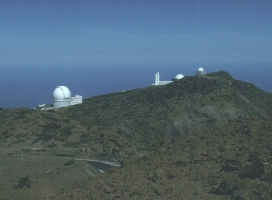
| 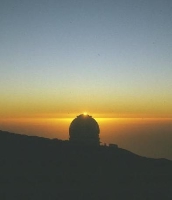
| 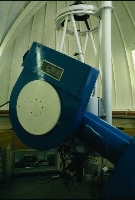
|
This spectacular site, on the northern rim of the Caldera de Taburiente at an altitude of about 2400 meters, has some of the best seeing I've ever measured. Astronomical development of the international observatory began in earnest with the decision to relocate the Isaac Newton Telescope from Herstmonceux in Sussex (which had interesting mechanical effects on the mounting, since that entailed a 25-degree latitude change). The William Herschel telescope combines the excellent site with very well-thought-out instrumentation for world-class results. I used these facilities several times while on a two-year stint at the Sterrewacht Leiden, since the Netherlands astronomical community contributes to the support of the La Palma operation. And more recently, I've been able to use the Nordic Optical Telescope for galaxy dynamics studies.

| 
| 
|
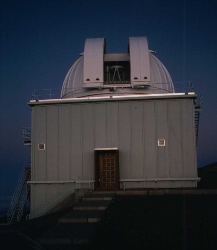
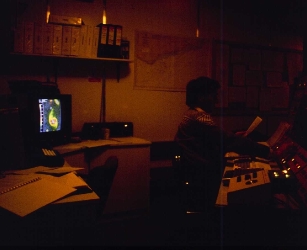 Peter Allan and I used the JKT to continue the quasar variability project that
we started with the Kitt Peak 1.3-m telescope - this sort of thing can happen
when both collaborators change continents. These data formed the basis
of a Master's thesis by Jose Maria Castro Ceron, which should be submitted
for journal publication any day now. We also used a CCD camera on the JKT for part
of a study of H-alpha emitting regions in interacting galaxies.
Peter Allan and I used the JKT to continue the quasar variability project that
we started with the Kitt Peak 1.3-m telescope - this sort of thing can happen
when both collaborators change continents. These data formed the basis
of a Master's thesis by Jose Maria Castro Ceron, which should be submitted
for journal publication any day now. We also used a CCD camera on the JKT for part
of a study of H-alpha emitting regions in interacting galaxies.
The JKT lies closer to the rim of the Caldera de Taburiente than any of the other telescopes. This means that observers might want to take a flashlight along when walking uphill from the dome at night. It's a long way down...
After a period of shutdown, the JKT is being refitted for remote operations late 2014, and is scheduled to join the observatories of the SARA consortium as of early 2015.
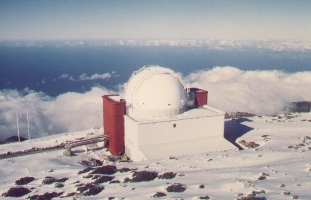
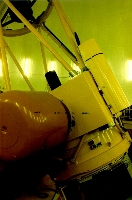 The Isaac Newton telescope has a very efficient and flexible spectrograph, very important when the UK and Dutch communities were using it to compete with
4-meter telescopes elsewhere (a role now ably handled by the WHT). The superb seeing
often encountered at La Palma made this an appealing setup for investigating
galactic nuclei. I took a series of high-dispersion spectra to study composite
nuclei, with signs of both star formation and nonstellar activity in close
proximity. Among other things, these data furnished evidence of a
massive black hole at the center of M81, as seen from the central rise
of stellar
velocity dispersion measured in subarcsecond seeing here. An INT spectrum
also furnished a
crucial clue to interpreting IUE and HST observations of
the nucleus of NGC 4569, a spiral in the Virgo cluster whose core is so
small that it was once mistaken for a foreground star. The optical spectrum
showed absorption-line profiles inconsistent with the most obvious
explanation of its colors, and that the nucleus must be (for whatever reason)
loaded with A-type supergiant stars.
The Isaac Newton telescope has a very efficient and flexible spectrograph, very important when the UK and Dutch communities were using it to compete with
4-meter telescopes elsewhere (a role now ably handled by the WHT). The superb seeing
often encountered at La Palma made this an appealing setup for investigating
galactic nuclei. I took a series of high-dispersion spectra to study composite
nuclei, with signs of both star formation and nonstellar activity in close
proximity. Among other things, these data furnished evidence of a
massive black hole at the center of M81, as seen from the central rise
of stellar
velocity dispersion measured in subarcsecond seeing here. An INT spectrum
also furnished a
crucial clue to interpreting IUE and HST observations of
the nucleus of NGC 4569, a spiral in the Virgo cluster whose core is so
small that it was once mistaken for a foreground star. The optical spectrum
showed absorption-line profiles inconsistent with the most obvious
explanation of its colors, and that the nucleus must be (for whatever reason)
loaded with A-type supergiant stars.
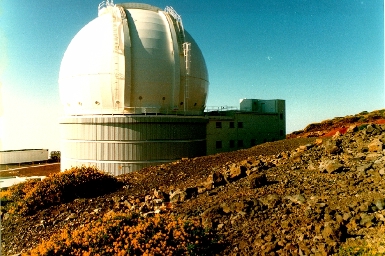 One of the new generation of large altazimuth telescopes, the WHT started
regular operation in 1987. Looking at the elevated walkways to the
telescope platform, I couldn't help thinking, "Another fine product
of Krell technology". Our team got one of the earliest normally scheduled
observing runs (almost canceled by brush fires). We used the Faint-Object
Spectrograph (shown below attached to the WHT)
to observe faint candidate active galactic nuclei (AGN) selected
from the deep fields observed by IRAS, parallel to its all-sky survey.
Encouraged by a period of subsrcsecond seeing which let us
split the components even on the acquisition TV, we also
sneaked in spectra of the different components of the
Einstein Cross
2237+030. The only difference that shows up is in foreground
Na D absorption from the foreground (lens) galaxy near 6070 Angstroms;
it is strongest for those images, such as C, where the impact
parameter from the galaxy nucleus is smallest.
One of the new generation of large altazimuth telescopes, the WHT started
regular operation in 1987. Looking at the elevated walkways to the
telescope platform, I couldn't help thinking, "Another fine product
of Krell technology". Our team got one of the earliest normally scheduled
observing runs (almost canceled by brush fires). We used the Faint-Object
Spectrograph (shown below attached to the WHT)
to observe faint candidate active galactic nuclei (AGN) selected
from the deep fields observed by IRAS, parallel to its all-sky survey.
Encouraged by a period of subsrcsecond seeing which let us
split the components even on the acquisition TV, we also
sneaked in spectra of the different components of the
Einstein Cross
2237+030. The only difference that shows up is in foreground
Na D absorption from the foreground (lens) galaxy near 6070 Angstroms;
it is strongest for those images, such as C, where the impact
parameter from the galaxy nucleus is smallest.
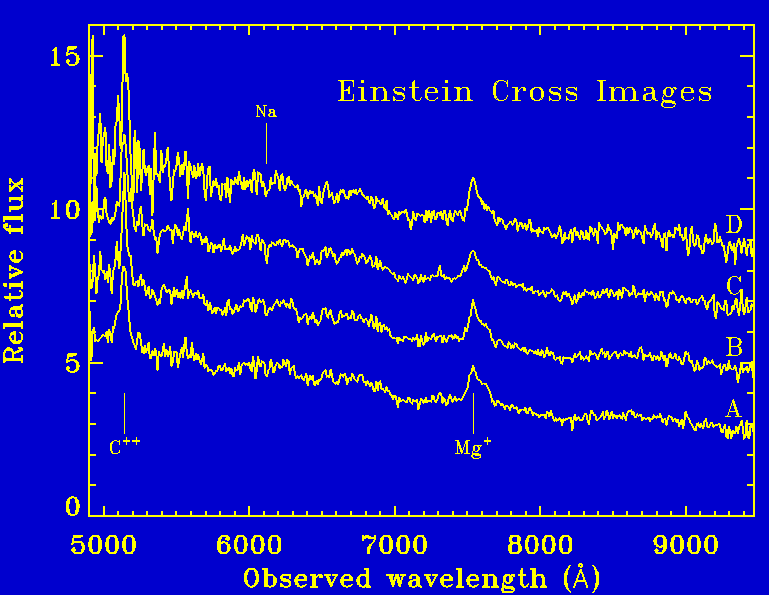
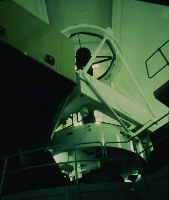
| 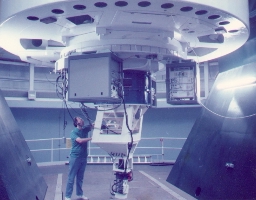
|
Here are some sample spectra of faint active galaxies as measured with the WHT. This is a group of Seyfert 2 galaxies found as warm far-infrared sources from examination of the deep IRAS pointed data. These are arranged by increasing redshift (given at the right side), whosing how the strong lines of Hβ, [O III] Hα, and [N II] march out of the optical window for even larger redshifts. They have been rescaled for comparison, in fact spanning two orders of magnitude in line flux.
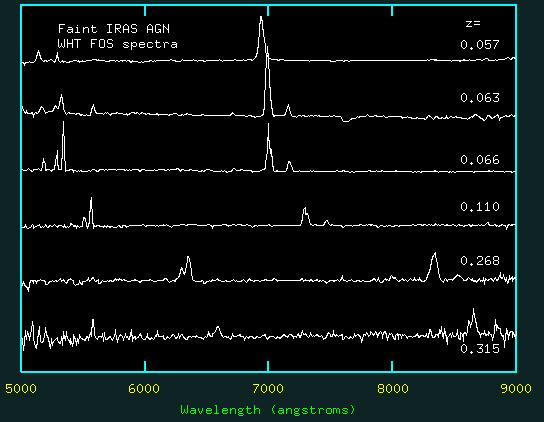
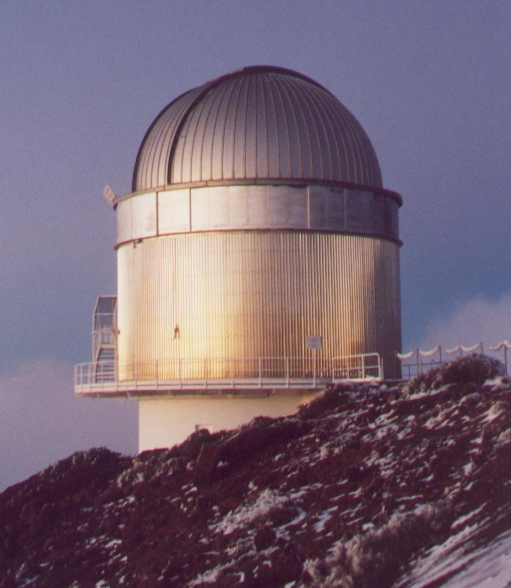
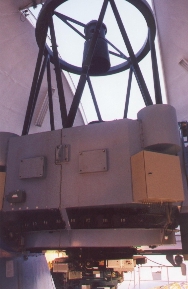 The compact, altazimuth-mounted NOT has achieved excellent images,
not only through optical quality but due to its compact lightweight
dome and the practice of opening huge vents to allow wind to flow right
through the enclosure.
The NOT dome turns as a unit with the telescope, allowing a very minimal
layout. It also means you should be very careful with walking in or out
of the dome at night...
The telescope is operated by institutions in
Norway, Sweden, Finland, Denmark, and Iceland. I've used it in a project
with Gene Byrd and
Mauri Valtonen to seek faint, tidally stripped companions of nearby edge-on
galaxies, which would serve as tracers of the halo dynamics and history
of these systems. Here is an R-band image of NGC 891, part of
an acquisition image while setting up for spectroscopy of
what turned out to be a background object.
The compact, altazimuth-mounted NOT has achieved excellent images,
not only through optical quality but due to its compact lightweight
dome and the practice of opening huge vents to allow wind to flow right
through the enclosure.
The NOT dome turns as a unit with the telescope, allowing a very minimal
layout. It also means you should be very careful with walking in or out
of the dome at night...
The telescope is operated by institutions in
Norway, Sweden, Finland, Denmark, and Iceland. I've used it in a project
with Gene Byrd and
Mauri Valtonen to seek faint, tidally stripped companions of nearby edge-on
galaxies, which would serve as tracers of the halo dynamics and history
of these systems. Here is an R-band image of NGC 891, part of
an acquisition image while setting up for spectroscopy of
what turned out to be a background object.
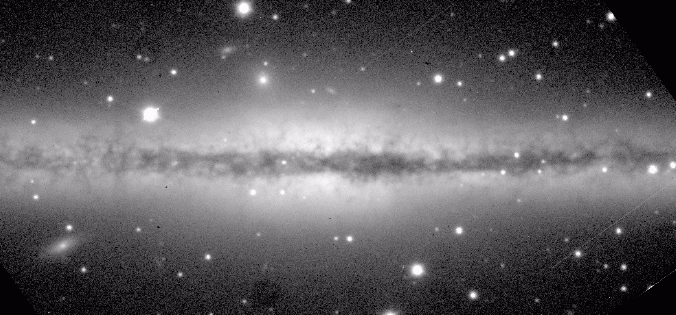
Still to come: JKT data on QSOs and galaxy H-alpha image. INT spectra of NGC 4569, M94, M81.
Other instruments are also sited at the Roque de los Muchachos. These include the Telescopio Nazionale Galileo and the Dutch Open Telescope. Galileo is a 3.5-m near-duplicate of the ESO New Technology Telescope (right down to the details of the enclosure).
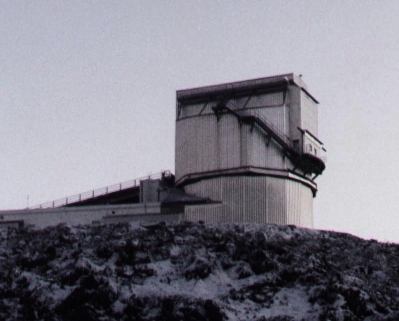
The Dutch Open Telescope is designed to improve image quality by having the telescope open to the air as far as possible. It currently hosts a 45-cm solar instrument, with the option of installing a primary as large as 70 cm. Any resemblance to a Martian tripod machine a la H.G. Wells is completely coincidental.
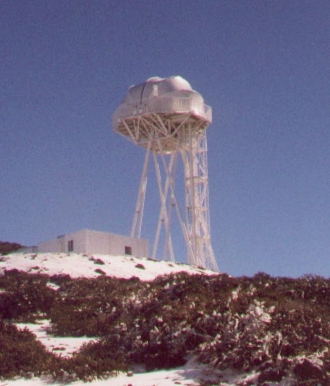
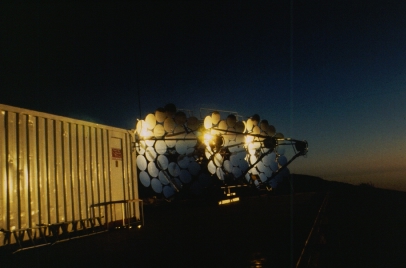
Last changes: 9/2014 © 1999-2014